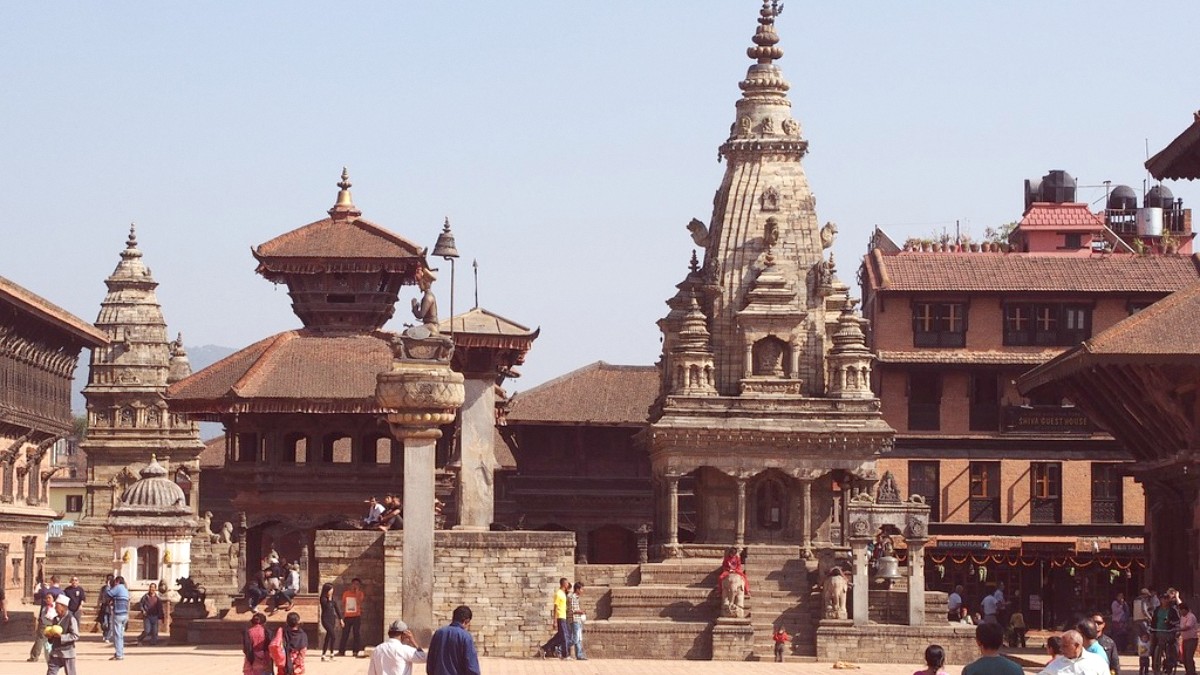
Around The Kathmandu Valley, Nepal
Bhaktapur experiences a temperate climate with four distinct seasons, each offering a different appeal. Temperatures are mild, humidity levels stay low, and skies are generally clear. Pre-monsoon showers become possible towards May.
The period of October-November is widely considered the most pleasant season for visiting Bhaktapur. Temperatures are mild and dry, averaging 15-25°C. Humidity is low, skies are typically clear, and the weather remains stable.
Nepal has distinct seasons. Travelers find different advantages depending on their priorities.
Autumn (October-November) offers pleasant weather, clear skies, and many festivals. This time sees more visitors and higher prices. Shoulder seasons (February, May, early December) have fewer crowds and good weather. The low season (June-September, January) brings lower prices and fewer tourists, but also rain or cold temperatures.
(Oct-Nov & Mar-Apr)
Ideal weather, clear skies, major festivals, best mountain views.
More crowds, higher accommodation/flight prices, advance booking.
(Feb, May, Early Dec)
Fewer crowds, reasonable weather, lower prices than peak season.
May can be hot/humid with showers. Feb/Dec can be cool.
(Jun-Sept & Jan)
Lowest prices, fewer tourists, authentic local interaction.
Heavy rain (monsoon), high humidity, very cold/foggy in January.
The monsoon season, from June to September, brings heavy rains. This can impact travel, especially if you plan to venture outside Bhaktapur to other parts of Nepal where roads may be slippery or prone to delays. Bhaktapur does not experience hurricanes.
While extreme temperatures are rare, winter mornings can drop close to freezing. Summer days can feel uncomfortably humid. Dressing in layers and checking forecasts will make travel better.
Best for sightseeing, photography, and cultural festivals like Dashain and Tihar.
Good for clear skies and comfortable temperatures before the monsoon.
Fewer crowds and reasonable weather, good for a more relaxed visit.
Cold but quiet, with opportunities for clear views on sunny days.
Lush green landscapes and low prices, but prepare for heavy rain.
Nepal makes visa acquisition straightforward for most nationalities.
Most nationalities can obtain a tourist visa on arrival at Tribhuvan International Airport (TIA) in Kathmandu, Nepal's sole international airport. Visas are also available at various land border crossings.
Gather these items for your visa application process.
Having comprehensive travel insurance is highly recommended. It safeguards against unforeseen events.
Nepal offers options for various budget levels. Daily costs are estimates and can vary based on individual choices and current economic conditions.
The official currency is the Nepalese Rupee (NPR), symbolized as रू or Rs. Exchange rates fluctuate; check current rates before and during your trip. For example, 1 USD is approximately 133 NPR as of early 2024.
You can exchange major currencies (USD, Euro, GBP) at Tribhuvan International Airport, banks, and authorized money changers in Kathmandu and Bhaktapur. ATMs are available in Bhaktapur, especially near the main squares. Be aware that ATMs may have withdrawal limits (typically NPR 25,000-30,000) and transaction fees.
Daily costs: NPR 2,500 - 4,500 (approx. US$19 - 34)
Accommodation: NPR 800-1,500 for guesthouse/hostel.
Limit taxis; use local buses and street food for savings.
Daily costs: NPR 6,000 - 12,000 (approx. US$45 - 90)
Accommodation: NPR 2,500-6,000 for comfortable hotel.
Balance local eateries with some mid-range restaurants.
Daily costs: NPR 15,000+ (approx. US$113+)
Accommodation: NPR 8,000+ for high-end boutique hotels.
Fine dining and private transport options available.
| Category | Price Range (NPR) | Example (Bhaktapur) |
|---|---|---|
| Hostel/Guesthouse | 800 - 1,500 | Hotel Golden Gate Guest House |
| Mid-range Hotel | 2,500 - 6,000 | Peacock Guest House, Hotel Heritage (lower end) |
| Luxury Boutique | 8,000 - 15,000+ | Hotel Heritage, Nayatapola Hotel |
Being aware of common concerns and how to address them makes your trip safer.
Yellow fever vaccination certificate if arriving from a yellow fever-risk country.
Routine vaccinations (MMR, DTP, Varicella, Polio, Flu shot).
Hepatitis A & B, Typhoid, Japanese Encephalitis (rural areas), Rabies (animal contact/remote areas).
Prevention is for a healthy trip.
Traveler's Diarrhea: Drink only bottled or purified water. Avoid ice, raw fruits/vegetables (unless peeled by you), and questionable street food. Carry Anti-diarrhea medication like Loperamide.
Altitude Sickness: Not a concern in Bhaktapur (1,400 meters). Only relevant if trekking to higher altitudes in other parts of Nepal. Air Pollution: Kathmandu Valley can experience noticeable air pollution, especially in dry winter. Consider carrying a face mask if you have respiratory sensitivities.
Mosquito-borne illnesses like Dengue fever are present, specifically during and after monsoon. Use Insect repellent with DEET or Picaridin. Wear long sleeves/pants. Rabies: Exists in stray animals. Avoid contact. If bitten, seek medical attention immediately.
Bhaktapur has local hospitals and clinics for basic care. For complex needs, Kathmandu has international-standard facilities like CIWEC Hospital and Norvic International Hospital. Pharmacies are readily available.
Police: 100, Fire: 101, Ambulance: 102. In an emergency, prioritize personal safety, then contact local authorities.
Tap water is not safe to drink without purification. Rely on bottled, boiled, or filtered water (Water filter bottle/Purification tablets). Eat at reputable establishments; practice frequent hand washing.
Bhaktapur is generally safe for tourists. Violent crime is rare, but petty crime like pickpocketing can occur in crowded areas. Be aware of your surroundings.
Keep these numbers readily available. In an emergency, first prioritize your personal safety, then contact local authorities.
Police: 100, Fire: 101, Ambulance: 102. Tourist Police: 1144.
Keep their contact details, including emergency numbers, readily available.
Note down your travel insurance emergency contact number.